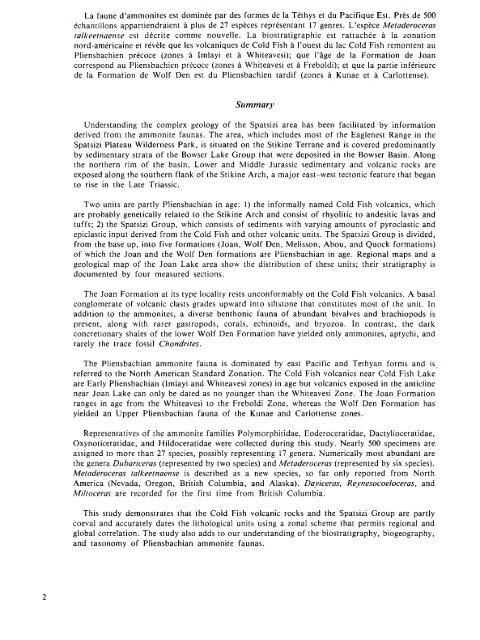PLIENSBACHIAN (LOWER JURASSIC) BIOSTRATIGRAPHY AND ...
PLIENSBACHIAN (LOWER JURASSIC) BIOSTRATIGRAPHY AND ...
PLIENSBACHIAN (LOWER JURASSIC) BIOSTRATIGRAPHY AND ...
You also want an ePaper? Increase the reach of your titles
YUMPU automatically turns print PDFs into web optimized ePapers that Google loves.
La faune d’ammonites est dominee par des formes de la Tethys et du Pacifique Est. Pres de 500<br />
echantillons appartiendraient a plus de 27 especes representant 17 genres. L’espece M etaderoceras<br />
talkeetnaense est decrite comme nouvelle. La biostratigraphie est rattachee a la zonation<br />
nord-americaine et revele que les volcaniques de Cold Fish a l’ouest du lac Cold Fish remontent au<br />
Pliensbachien precoce (zones a Imlayi et a Whiteavesi); que l’age de la Formation de Joan<br />
correspond au Pliensbachien precoce (zones a Whiteavesi et a Freboldi); et que la partie inferieure<br />
de la Formation de Wolf Den est du Pliensbachien tardif (zones a Kunae et a Carlottense).<br />
Summary<br />
Understanding the complex geology of the Spatsizi area has been facilitated by information<br />
derived from the ammonite faunas. The area, which includes most of the Eaglenest Range in the<br />
Spatsizi Plateau Wilderness Park, is situated on the Stikine Terrane and is covered predominantly<br />
by sedimentary strata of the Bowser Lake Group that were deposited in the Bowser Basin. Along<br />
the northern rim of the basin, Lower and Middle Jurassic sedimentary and volcanic rocks are<br />
exposed along the southern flank of the Stikine Arch, a major east-west tectonic feature that began<br />
to rise in the Late Triassic.<br />
Two units are partly Pliensbachian in age: 1) the informally named Cold Fish volcanics, which<br />
are probably genetically related to the Stikine Arch and consist of rhyolitic to andesitic lavas and<br />
tuffs; 2) the Spatsizi Group, which consists of sediments with varying amounts of pyroclastic and<br />
epiclastic input derived from the Cold Fish and other volcanic units. The Spatsizi Group is divided,<br />
from the base up, into five formations (Joan, Wolf Den, Melisson, Abou, and Quock formations)<br />
of which the Joan and the Wolf Den formations are Pliensbachian in age. Regional maps and a<br />
geological map of the Joan Lake area show the distribution of these units; their stratigraphy is<br />
documented by four measured sections.<br />
The Joan Formation at its type locality rests unconformably on the Cold Fish volcanics. A basal<br />
conglomerate of volcanic clasts grades upward into siltstone that constitutes most of the unit. In<br />
addition to the ammonites, a diverse benthonic fauna of abundant bivalves and brachiopods is<br />
present, along with rarer gastropods, corals, echinoids, and bryozoa. In contrast, the dark<br />
concretionary shales of the lower Wolf Den Formation have yielded only ammonites, aptychi, and<br />
rarely the trace fossil Chondrites.<br />
The Pliensbachian ammonite fauna is dominated by east Pacific and Tethyan forms and is<br />
referred to the North American Standard Zonation. The Cold Fish volcanics near Cold Fish Lake<br />
are Early Pliensbachian (Imlayi and Whiteavesi zones) in age but volcanics exposed in the anticline<br />
near Joan Lake can only be dated as no younger than the Whiteavesi Zone. The Joan Formation<br />
ranges in age from the Whiteavesi to the Freboldi Zone, whereas the Wolf Den Formation has<br />
yielded an Upper Pliensbachian fauna of the Kunae and Carlottense zones.<br />
Representatives of the ammonite families Polymorphitidae, Eoderoceratidae, Dactylioceratidae,<br />
Oxynoticeratidae, and Hildoceratidae were collected during this study. Nearly 500 specimens are<br />
assigned to more than 27 species, possibly representing 17 genera. Numerically most abundant are<br />
the genera Dubariceras (represented by two species) and Metaderoceras (represented by six species).<br />
M etaderoceras talkeetnaense is described as a new species, so far only reported from North<br />
America (Nevada, Oregon, British Columbia, and Alaska). Dayiceras, Reynesocoeloceras, and<br />
M iltoceras are recorded for the first time from British Columbia.<br />
This study demonstrates that the Cold Fish volcanic rocks and the Spatsizi Group are partly<br />
coeval and accurately dates the lithological units using a zonal scheme that permits regional and<br />
global correlation. The study also adds to our understanding of the biostratigraphy, biogeography,<br />
and taxonomy of Pliensbachian ammonite faunas.

















